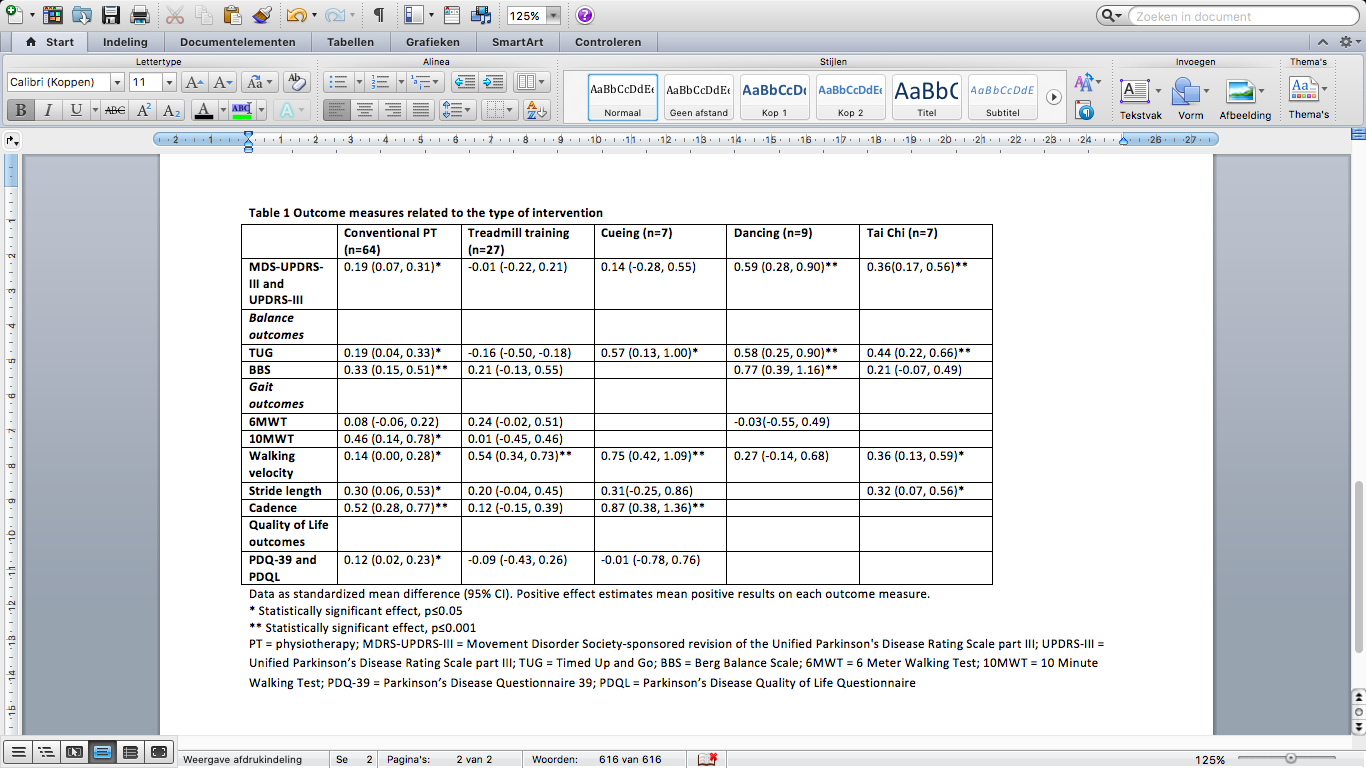Session Information
Date: Tuesday, June 6, 2017
Session Title: Therapy in Movement Disorders
Session Time: 1:45pm-3:15pm
Location: Exhibit Hall C
Objective: Physiotherapy (PT) is widely recognized as an intervention for people with Parkinson’s disease (PD). Many controlled trials have evaluated conventional PT, and the evidence for newer treatments such as Tai Chi or dance is increasing. Here, we evaluate the effectiveness of conventional PT, treadmill training, cueing, dance and Tai Chi, as compared to no or sham treatment.
Background: Many non-pharmacological interventions can contribute to the management of PD, and PT is applied most widely. PT consists of many different types and modalities. Their mutual main goal is to maximize the quality of movement, functional independence and general fitness, whilst supporting self-management. There is no review that summarizes the effectiveness of these treatment modalities in current literature.
Methods: As a basis for the European Guideline for Physiotherapy in PT (published in 2012), we performed a meta-analysis of the available literature on PT in PD. We have updated this meta-analysis with the latest scientific evidence, using the same search strategy. The extensive search strategy can be found at www.parkinsonnet.info/euguideline. In total, 182 controlled clinical trials were found, of which 114 were included in the analysis. The remaining 68 studies were excluded for various reasons, mainly because the intervention was not considered to be PT (e.g. only one day of treatment or combined treatments).
Results: In table 1 we present the preliminary results. All interventions showed effectiveness for people with PD. Conventional PT significantly improved all outcomes shown in the table, except for the 6 Minute Walk Test. Treadmill training only improved walking speed. Cueing significantly improved gait parameters, while dancing was mostly effective for motor symptoms and balance measures. Finally, Tai Chi had the biggest effect on motor symptoms, balance and gait.
Conclusions: This meta-analysis shows that a variety of PT interventions are effective for patients with PD. Based on the present results, an evidence based decision for a specific treatment modality can be made. Moreover, it gives patients and their health providers a choice and therefore these results support a more patient-centered treatment.
To cite this abstract in AMA style:
D. Radder, N. de Vries, M. Faber, M. van Nimwegen, S. Keus, B. Bloem. Treadmill training, Tai Chi, dance and more: a meta-analysis on the effectiveness of different physiotherapy modalities in Parkinson’s disease [abstract]. Mov Disord. 2017; 32 (suppl 2). https://www.mdsabstracts.org/abstract/treadmill-training-tai-chi-dance-and-more-a-meta-analysis-on-the-effectiveness-of-different-physiotherapy-modalities-in-parkinsons-disease/. Accessed April 2, 2025.« Back to 2017 International Congress
MDS Abstracts - https://www.mdsabstracts.org/abstract/treadmill-training-tai-chi-dance-and-more-a-meta-analysis-on-the-effectiveness-of-different-physiotherapy-modalities-in-parkinsons-disease/

